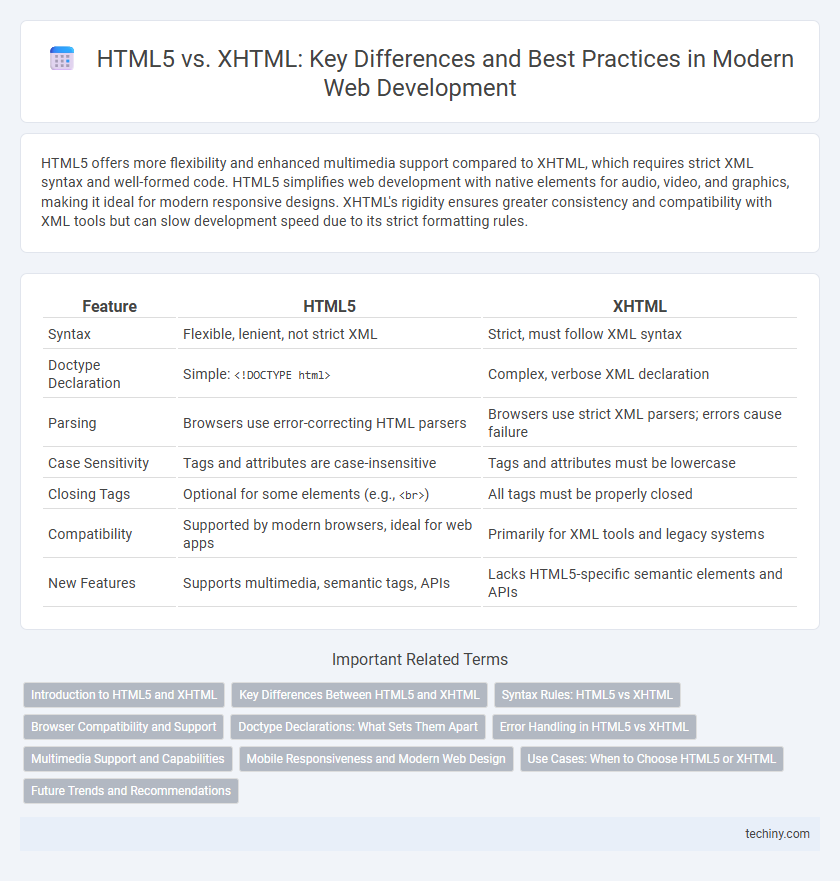HTML5 offers more flexibility and enhanced multimedia support compared to XHTML, which requires strict XML syntax and well-formed code. HTML5 simplifies web development with native elements for audio, video, and graphics, making it ideal for modern responsive designs. XHTML's rigidity ensures greater consistency and compatibility with XML tools but can slow development speed due to its strict formatting rules.
Table of Comparison
| Feature | HTML5 | XHTML |
|---|---|---|
| Syntax | Flexible, lenient, not strict XML | Strict, must follow XML syntax |
| Doctype Declaration | Simple: <!DOCTYPE html> |
Complex, verbose XML declaration |
| Parsing | Browsers use error-correcting HTML parsers | Browsers use strict XML parsers; errors cause failure |
| Case Sensitivity | Tags and attributes are case-insensitive | Tags and attributes must be lowercase |
| Closing Tags | Optional for some elements (e.g., <br>) |
All tags must be properly closed |
| Compatibility | Supported by modern browsers, ideal for web apps | Primarily for XML tools and legacy systems |
| New Features | Supports multimedia, semantic tags, APIs | Lacks HTML5-specific semantic elements and APIs |
Introduction to HTML5 and XHTML
HTML5 is the latest version of the Hypertext Markup Language, designed to support multimedia, graphic content, and improved scripting capabilities on web pages while maintaining backward compatibility with older browsers. XHTML, an XML-based extension of HTML, requires strict syntax rules and well-formed documents to ensure consistent parsing and compatibility with XML tools. Both languages are fundamental for web development, but HTML5 offers greater flexibility and enhanced features for modern web applications.
Key Differences Between HTML5 and XHTML
HTML5 offers a flexible syntax that allows omission of certain tags and is case-insensitive, while XHTML requires strict XML syntax with all tags properly closed and lowercase. HTML5 supports multimedia elements like
Syntax Rules: HTML5 vs XHTML
HTML5 syntax allows flexible tag closures and attribute quoting, supporting both case-insensitive tags and optional end tags for simpler coding. XHTML enforces strict XML syntax rules, requiring all tags to be properly closed, attributes quoted, and element names in lowercase to ensure well-formedness. Browsers parse HTML5 with error-tolerant algorithms, while XHTML demands strict compliance to XML parsing standards, impacting document rendering and error handling.
Browser Compatibility and Support
HTML5 offers broader browser compatibility and support compared to XHTML, as it is designed to be backward-compatible with older browsers while supporting modern web features. XHTML requires stricter syntax rules and XML parsing, which can cause rendering issues or incompatibility in some browsers without XML support. Most contemporary browsers fully support HTML5, making it the preferred choice for ensuring consistent display and functionality across diverse user agents.
Doctype Declarations: What Sets Them Apart
HTML5 employs a simple and flexible Doctype declaration ``, ensuring quick browser recognition and backward compatibility. XHTML requires a stricter Doctype declaration that corresponds to specific XML schemas, enforcing rigorous syntax rules and validation for XML compliance. This divergence in Doctype declarations highlights HTML5's ease of use versus XHTML's emphasis on strict standard adherence and well-formed code.
Error Handling in HTML5 vs XHTML
HTML5 offers more flexible error handling by allowing browsers to automatically correct and display pages with minor syntax errors, enhancing user experience without strict conformity. XHTML, being XML-based, requires well-formed code and strict error handling, causing browsers to stop rendering and display error messages when parsing issues occur. This strict error enforcement in XHTML ensures higher code precision but can lead to usability issues if errors are not fixed promptly.
Multimedia Support and Capabilities
HTML5 offers robust multimedia support with native elements like
Mobile Responsiveness and Modern Web Design
HTML5 provides greater flexibility and enhanced support for mobile responsiveness through built-in multimedia elements, semantic tags, and APIs that enable adaptive, fluid layouts critical for modern web design. XHTML's strict XML syntax, while promoting cleaner code, can hinder rapid development and complicate mobile optimization due to its rigidity and lesser support in contemporary browsers. Leveraging HTML5's responsive design features such as viewport controls, flexible grids, and media queries significantly improves user experience across diverse mobile devices.
Use Cases: When to Choose HTML5 or XHTML
HTML5 is ideal for modern web applications requiring multimedia, offline storage, and responsive design due to its robust support for audio, video, and dynamic content. XHTML suits projects demanding strict XML compliance, such as enterprise environments prioritizing consistent parsing and data interchange. Choosing between HTML5 and XHTML depends on the need for flexibility and rich media (HTML5) or the benefits of XML syntax and validation (XHTML).
Future Trends and Recommendations
HTML5 continues to dominate web development due to its flexibility, extensive multimedia support, and backward compatibility, securing its position as the preferred standard for future projects. XHTML, while enforcing stricter XML syntax and improved code consistency, faces declining adoption because modern browsers prioritize HTML5's versatility and ease of use. Developers are recommended to adopt HTML5 for new applications, leveraging its rich APIs and responsive design capabilities, while maintaining XHTML knowledge for legacy systems and specialized XML integration.
HTML5 vs XHTML Infographic

 techiny.com
techiny.com